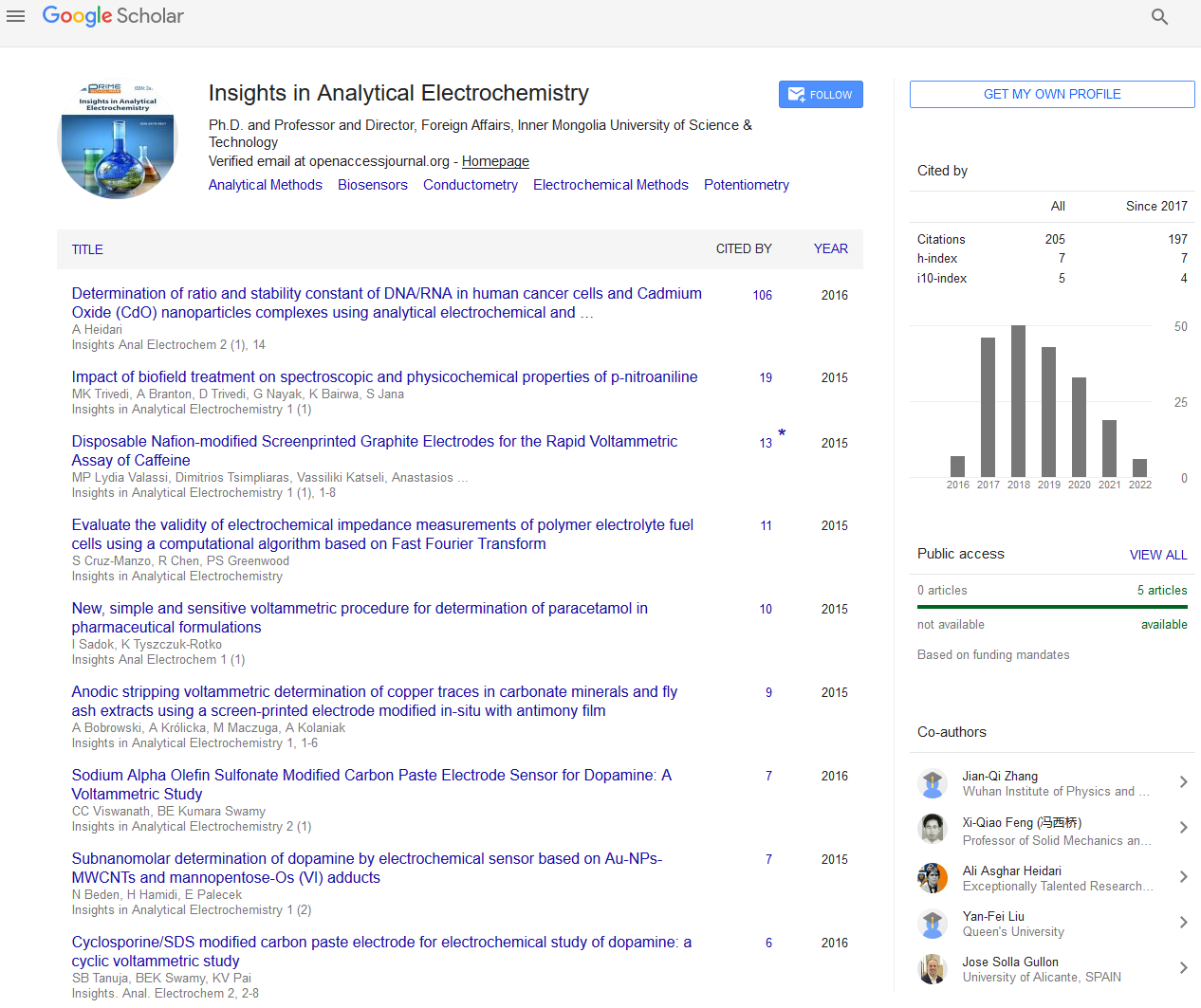Short Communication - (2024) Volume 10, Issue 2
The Role of Redox Reactions in Environmental Chemistry: Mechanisms, Applications, and Challenges
Emily Roberts*
Department of Environmental Science, Stanford University, USA
*Correspondence:
Emily Roberts,
Department of Environmental Science, Stanford University,
USA,
Email:
Received: 29-May-2024, Manuscript No. IPAEI-24-20796;
Editor assigned: 31-May-2024, Pre QC No. IPAEI-24-20796 (PQ);
Reviewed: 14-Jun-2024, QC No. IPAEI-24-20796;
Revised: 19-Jun-2024, Manuscript No. IPAEI-24-20796 (R);
Published:
26-Jun-2024, DOI: 10.36648/2470-9867.24.10.20
Introduction
Redox reactions, involving the transfer of electrons between
chemical species, are pivotal in environmental chemistry. These
reactions underpin various natural and artificial processes that
affect the environment, such as nutrient cycling, pollutant
degradation, and energy transfer. By understanding and
harnessing redox reactions, scientists can develop innovative
solutions to environmental challenges, from pollution
remediation to sustainable energy production. This article
examines the mechanisms of redox reactions, their applications
in environmental chemistry, and the challenges associated with
their practical implementation [1,2]. Redox reactions consist
of two interrelated half-reactions: Oxidation, where a species
loses electrons, and reduction, where a species gains electrons.
A common example is the reduction of nitrate to nitrogen gas
by bacteria in soil.
Description
Redox reactions can also involve complex organic molecules
and occur in multiple steps, as seen in the decomposition
of organic pollutants. These reactions can be catalysed by
enzymes or other catalysts to increase the reaction rate
and specificity. Understanding the intricate details of these
mechanisms is crucial for advancements in environmental
chemistry. Redox reactions have wide-ranging applications in
environmental chemistry, addressing key environmental issues.
Redox reactions are central to the breakdown of pollutants.
For example, Advanced Oxidation Processes (AOPs) use redox
reactions to degrade organic contaminants in water treatment.
Drive nutrient cycles such as the nitrogen and sulphur cycles.
These cycles are essential for ecosystem health, influencing
plant growth and soil quality. Microorganisms utilize redox
reactions to detoxify contaminated environments. In
bioremediation, bacteria and fungi convert harmful pollutants
into less toxic forms, using redox processes. Redox reactions
in bio electrochemical systems, such as microbial fuel cells,
convert organic matter into electricity. This technology offers a
sustainable way to treat wastewater while generating energy.
Redox-sensitive indicators and sensors are used to monitor
environmental conditions. These tools help in detecting
pollution levels and assessing the health of ecosystems.
Natural environments are complex and dynamic, making it
difficult to predict and control redox processes. Scaling up
laboratory findings to field applications is challenging. Factors
such as variable environmental conditions and the presence
of multiple contaminants complicate the implementation. The
cost of technologies based on redox reactions can be high. The
use of chemicals and energy in redox-based treatments must
be sustainable. Balancing effectiveness with environmental
impact is essential for long-term viability. Redox reactions in
environmental chemistry are pivotal for addressing emerging
challenges such as climate change and pollution. They offer
promising avenues for developing sustainable technologies
that can mitigate environmental impacts while promoting
resource efficiency. Advances in analytical techniques, including
spectroscopy and electrochemical methods, are enhancing
our ability to study and harness redox reactions in complex
environmental matrices [3,4].
Conclusion
Redox reactions play a vital role in environmental chemistry,
offering solutions to pollution, nutrient management, and
sustainable energy. By advancing our understanding of these
reactions, we can enhance their applications and overcome
associated challenges. Continued research and innovation
in redox chemistry are crucial for developing effective
environmental technologies. As we address the complexities and scalability issues, redox reactions will remain a cornerstone
of strategies to protect and improve our environment.
Collaborative efforts between scientists, engineers, and
policymakers are essential to optimize redox-based solutions
and integrate them into broader environmental management
strategies. By leveraging the versatility of redox chemistry, we
can foster a greener future that balances economic growth
with environmental stewardship.
Acknowledgement
None.
Conflict Of Interest
The author’s declared that they have no conflict of interest.
References
- Piliang H, Sunil S, Adav D (2017) Recent advances in mass spectrometric analysis of protein deamidation. Mass Spectrom Rev 36(6): 677-692.
[Crossref] [Google Scholar] [PubMed]
- Noyhouzer T, Valdinger I, Mandler D (2013) Enhanced potentiometry by metallic nanoparticles. Anal Chem 85(17): 8347-8353.
[Crossref] [Google Scholar] [PubMed]
- Sun J, Geng Z, Xue N (2018) A mini-system integrated with metal-oxide-semiconductor sensor and micro-packed gas chromatographic column. Micromachines 9(8): 408.
[Crossref] [Google Scholar] [PubMed]
- Hurtado M, Davidson JL, Blyth CA, Lowe J (2010) Holographic detection of hydrocarbon gases and other volatile organic compounds. Langmuir 26(19): 15694-15699.
[Crossref] [Google Scholar] [PubMed]
Citation: Roberts E (2024) The Role of Redox Reactions in Environmental Chemistry: Mechanisms, Applications, and Challenges. Insights Anal Electrochem. 10:20.
Copyright: © 2024 Roberts E. This is an open-access article distributed under the terms of the Creative Commons Attribution License, which permits unrestricted use, distribution, and reproduction in any medium, provided the original author and source are credited.

